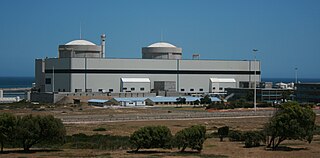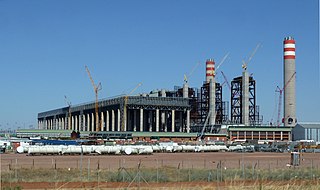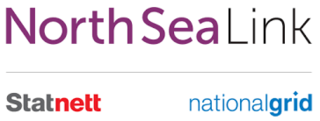
Koeberg Nuclear Power Station is a nuclear power station in South Africa. It is currently the only one on the entire African continent. It is located 30 km north of Cape Town, near Melkbosstrand on the west coast of South Africa. Koeberg is owned and operated by the country's only national electricity supplier, Eskom.
Eskom Hld SOC Ltd or Eskom (Afrikaans: Elektrisiteitsvoorsieningskommissie) is a South African electricity public utility. Eskom was established in 1923 as the Electricity Supply Commission (ESCOM). Eskom represents South Africa in the Southern African Power Pool. The utility is the largest producer of electricity in Africa, and was among the top utilities in the world in terms of generation capacity and sales. It is the largest of South Africa's state owned enterprises. Eskom operates a number of notable power stations, including Matimba Power Station and Medupi Power Station in Lephalale, Kusile Power Station in Witbank, Kendal Power Station, and Koeberg Nuclear Power Station in the Western Cape Province, the only nuclear power plant in Africa.

Earthlife Africa is a South African environmental and anti-nuclear organisation founded in August 1988, in Johannesburg. Initially conceived of as a South African version of Greenpeace, the group began by playing a radical, anti-apartheid, activist role. ELA is arguably now more of a reformist lobby or pressure group. Considered by some to be a key voice in the emerging environmental justice movement, Earthlife Africa has been criticised for being too radical, and by others for "working with traditional conservation movements" in furthering the environmental struggle.

The Palmiet Pumped Storage Scheme consists of two 200 megawatts (270,000 hp) turbine units located 2 kilometres (1.2 mi) upstream of the Kogelberg Dam on the Palmiet River near Cape Town, South Africa. The pumped-storage hydroelectricity plant is capable of responding to a surge in peak power demand in minutes. At night, excess power on the grid generated by conventional coal and nuclear plants is used to pump water to the upper Rockview Dam overlooking Gordon's Bay.
The Koeberg Alert alliance is an anti-nuclear activist organisation which emerged from an earlier pressure group in Cape Town called "Stop Koeberg" in 1983. Both were intended to halt construction of the first nuclear power station in South Africa at Duynefontein, 28 km NNW of Cape Town: the Koeberg Nuclear Power Station.
Thyspunt is a rocky stretch of coast approximately 12 km WNW of Cape Saint Francis in the Eastern Cape province of South Africa. It is just west of the beach Thysbaai and south-east of Oyster Bay. The point is near the popular surfing beach of Jeffreys Bay as well as the holiday town of St Francis Bay. It lies about 18 km SSW of the town of Humansdorp.
Bantamsklip is a rocky stretch of coast approximately 7 km SE of Pearly Beach in the Overberg district of the Western Cape province of South Africa. The site is 23 km south east of the town of Gansbaai.
Brazil is a coastal site near Kleinzee in the Namakwa district of the Northern Cape province of South Africa. The site is approximately 85 km west of the town of Springbok.
Schulpfontein is a coastal site near Hondeklip Bay in the Namakwa district of the Northern Cape province of South Africa. The site is approximately 95 km south-west of the town of Springbok
The Ingula Pumped Storage Scheme is a pumped-storage power station in the escarpment of the Little Drakensberg range straddling the border of the KwaZulu-Natal and Free State provinces, South Africa. It is about 22 km (14 mi) North-East of Van Reenen.

Medupi Power Station is a dry-cooled coal-fired power station built by Eskom near Lephalale in Limpopo province, South Africa. The station consists of 6 generating units with a nameplate capacity of 800 MW each bringing the total installed capacity of 4,800 MW.

The North Sea Link is a 1,400 MW high-voltage direct current submarine power cable between Norway and the United Kingdom.

South Africa is the only country in Africa with a commercial nuclear power plant.
South Africa has a large energy sector, being the third-largest economy in Africa. The country consumed 227 TWh of electricity in 2018. The vast majority of South Africa's electricity was produced from coal, with the fuel responsible for 88% of production in 2017. South Africa is the 7th largest coal producer in the world. As of July 2018, South Africa had a coal power generation capacity of 39 gigawatts (GW). South Africa is the world's 14th largest emitter of greenhouse gases. South Africa is planning to shift away from coal in the electricity sector and the country produces the most solar and wind energy by terawatt-hours in Africa. The country aims to decommission 34 GW of coal-fired power capacity by 2050. It also aims to build at least 20 GW of renewable power generation capacity by 2030. South Africa aims to generate 77,834 megawatts (MW) of electricity by 2030, with new capacity coming significantly from renewable sources to meet emission reduction targets. Through its goals stated in the Integrated Resource Plan, it announced the Renewable Energy Independent Power Producer Procurement Programme, which aims to increase renewable power generation through private sector investment.
Shetland HVDC Connection is a high-voltage direct current submarine power cable under construction to connect Shetland to the British mainland.

Kusile Power Station in South Africa is a coal-fired power plant by state electricity utility Eskom in Mpumalanga. The station consists of 6 generating units with a eventual nameplate capacity of 800 MW each bringing the total installed capacity of 4,800 MW
West Indian Ocean Cable Company (WIOCC) operates as a wholesaler, providing capacity to international telecoms, cloud operators, content providers and internet service providers within and out of Africa. WIOCC offers carriers connectivity to over 550 locations across 30 African countries – utilising more than 75,000 km (47,000 mi) of terrestrial fibre and 200,000 km (120,000 mi) of submarine fibre-optic cable. WIOCC's international network reach currently extends to 100 cities in 29 countries in Europe and more than 700 cities in 70 countries globally.

The South African energy crisis or load shedding is an ongoing period of widespread national blackouts of electricity supply. It began in the later months of 2003 towards the end of Thabo Mbeki's second term as president, and continues to the present. The South African government-owned national power utility, and primary power generator, Eskom, and various parliamentarians attributed these rolling blackouts to insufficient generation capacity.








